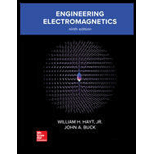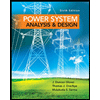
Engineering Electromagnetics
9th Edition
ISBN: 9780078028151
Author: Hayt, William H. (william Hart), Jr, BUCK, John A.
Publisher: Mcgraw-hill Education,
expand_more
expand_more
format_list_bulleted
Concept explainers
Textbook Question
Chapter 10, Problem 10.12P
In a circuit in which a sinusoidal voltage source drives its internal impedance in series with a load impedance, maximum power transfer to the load occurs when the source and load impedances form a complex conjugate pair. Suppose the source (with its internal impedance) now drives a complex load of impedance ZL = RL +XL that has been moved to the end of a lossless transmission line of length
Expert Solution & Answer
Want to see the full answer?
Check out a sample textbook solution
Students have asked these similar questions
A 50Ω lossless transmission line is terminated with a load impedance valued ZL = RL + jXL.According to what is given,
a) RL for Voltage Standing Wave Ratio to be 2What should be the relationship between XL and?b) If RL = 100Ω, find the value of XL.c) Find the voltage minimum point closest to the load on the line.
A lossless transmission line has 100 ? characteristic impedance. The line is terminated in a load impedance of 70-j100 ?. The maximum voltage measured on the line is 200V. Find;1. The minimum current and minimum voltage on the line2. Explain how location of voltage maximum can be determined by using load reflection coefficient from the forward and backward wave.3. Using load reflection coefficient in ii., calculate the distance from the load that produce the maximum voltage and current.
A three-phase power of 460 MW is transmitted to a substation located 500 km from the source of power. With VS=1 per unit, VR=0.9 per unit, λ =5000 km, Zc =500 V, and δ=36.878, determine a nominal voltagen level for the lossless transmission line based on Eq. (5.4.29) of the text. Using this result, find the theoretical three-phase maximum power that can be transferred by the lossless transmission line.
Chapter 10 Solutions
Engineering Electromagnetics
Ch. 10 - The parameters of a certain transmission line...Ch. 10 - A sinusoidal wave on a transmission line is...Ch. 10 - Prob. 10.3PCh. 10 - A sinusoidal voltage V0, frequency , and phase...Ch. 10 - Two voltage waves of equal amplitude V0 and radian...Ch. 10 - A 50 load is attached to a 50-m section of the...Ch. 10 - Prob. 10.7PCh. 10 - An absolute measure of power is the dBm scale, in...Ch. 10 - A 100-m transmission line is used to propagate a...Ch. 10 - Two lossless transmission lines having different...
Ch. 10 - Two voltage waves of equal amplitude V0, which...Ch. 10 - In a circuit in which a sinusoidal voltage source...Ch. 10 - The skin effect mechanism in transmission lines is...Ch. 10 - A lossless transmission line having characteristic...Ch. 10 - Figure 10.29 See Problem 10.15. For the...Ch. 10 - A 100 lossless transmission line is connected to a...Ch. 10 - Determine the average power absorbed by each...Ch. 10 - The line shown in Figure 10.31 is lossless. Find s...Ch. 10 - A lossless transmission line is 50 cm in length...Ch. 10 - (a) Determine s on the transmission line of Figure...Ch. 10 - Prob. 10.21PCh. 10 - Prob. 10.22PCh. 10 - The normalized load on a lossless transmission...Ch. 10 - Prob. 10.24PCh. 10 - Prob. 10.25PCh. 10 - A 75 lossless line is of length 1.2 . It is...Ch. 10 - Prob. 10.27PCh. 10 - The wavelength on a certain lossless line is 10...Ch. 10 - Prob. 10.29PCh. 10 - A two-wire line constructed of lossless wire of...Ch. 10 - In order to compare the relative sharpness of the...Ch. 10 - In Figure 10.17, let ZL=250 and Z0=50. Find the...Ch. 10 - In Figure 10.17, let ZL=100+j150 and Z0=100. Find...Ch. 10 - The lossless line shown in Figure 10.35 is...Ch. 10 - Prob. 10.35PCh. 10 - The two-wire lines shown in Figure 10.36 are all...Ch. 10 - Prob. 10.37PCh. 10 - Repeat Problem 10.37, with, Z0=50 and RL=Rg=25....Ch. 10 - In the transmission line of Figure 10.20, Z0=50,...Ch. 10 - In the charged line of Figure 10.25, the...Ch. 10 - In the transmission line of Figure 10.37, the...Ch. 10 - Figure 10.38 See Problem 10.42. A simple frozen...Ch. 10 - Figure 10.39 See Problem 10.43. In Figure 10.39,...
Knowledge Booster
Learn more about
Need a deep-dive on the concept behind this application? Look no further. Learn more about this topic, electrical-engineering and related others by exploring similar questions and additional content below.Similar questions
- The capacitance per unit length and the inductance per unit length for a lossless transmission line are 0.1 F/m and 20 H/m respectively. What will be the characteristic impedance of the line?arrow_forwardA lossless transmission line having 50 Ω characteristic impedance and length λ/4 is short-circuited at one end and connected to an ideal voltage source of 1V at the other end. Find the current drawn from the voltage sources.arrow_forwardA 500-kV, 300-km, 6()-Hz, three-phase overhead transmission line, assumed to be lossless, has a series inductance of 0.97 mH/krn per phase and a shunt capacitance of 0.0115F/km. per phase. (a) Determine the phase constant p, the surge impedance Zc, velocity of propagation v, and the wavelength of the line (b) Determine the voltage, current, real and reactive power at the sending end, and the percent voltage regulation of the line if the receiving-end load is 800 MW at 0.8 power factor lagging and at 500 kV.arrow_forward
- A lossless transmission with characteristic impedance of ?0 = 100Ω and length = 52cmThe line was terminated with a load of ?? = 30 + ?50Ω. According to what is given, a) The reflection coefficient in the load and the voltage standing wave ratio on the line (GDDO)Find out.b) Find the impedance and admittance at the line input. (for ? = 750???)c) For ? = 750???, the impedance and admittance values 2cm away from the load.(It will be assumed that = ?0.)arrow_forwardVk(t)= 9cos2π * 10^6(t) volt Voltage of a lossless transmission line fed by its source parameters, C= 0,01 μF/m, L= 0,02 mH/m line length d= 0,5 λ, load impedance ZL= 50 ohm (a)γ=? (b)Z0=? (c)Ve=? (d)Total voltage and current on the line write the equations in the complex space. (e)Voltage and current on the load Obtain the expression. (f)Time of reflected current wave Write the expression in the space and draw. lesson: electrical and electronical engineeringarrow_forwardFor a lossless trabsmisison line, the characteristic impedance is 80 ohm. If the capacitance per unit length is 1.5 mh/m then what will be the inductance per unit length.arrow_forward
- A transmission line in air with characteristic impedance Z0=50 ohm is terminated with a load impedance ZL ohm. What is the propogation constant k of the transmission line (assuming a coaxial line) for a 100 MHz uniform plane wave? What is the equivalence impedance of Z(-l) at l=.75m when ZL=25-j200 ohm? Calculate the shunt admittance to be added at l=.75m so that the line matched.arrow_forwardConsider a transmission line with characteristic impedance (Zo) of value 50Ω, if the value of the measured VSWR is 2, determine the magnitude of the load (Zl ) connected to that line that generates such value.arrow_forward
arrow_back_ios
arrow_forward_ios
Recommended textbooks for you
 Power System Analysis and Design (MindTap Course ...Electrical EngineeringISBN:9781305632134Author:J. Duncan Glover, Thomas Overbye, Mulukutla S. SarmaPublisher:Cengage Learning
Power System Analysis and Design (MindTap Course ...Electrical EngineeringISBN:9781305632134Author:J. Duncan Glover, Thomas Overbye, Mulukutla S. SarmaPublisher:Cengage Learning

Power System Analysis and Design (MindTap Course ...
Electrical Engineering
ISBN:9781305632134
Author:J. Duncan Glover, Thomas Overbye, Mulukutla S. Sarma
Publisher:Cengage Learning
Maximum Power Transfer Theorem Using Nodal Analysis & Thevenin Equivalent Circuits; Author: The Organic Chemistry Tutor;https://www.youtube.com/watch?v=8CA6ZNXgI-Y;License: Standard Youtube License